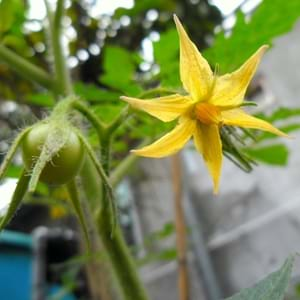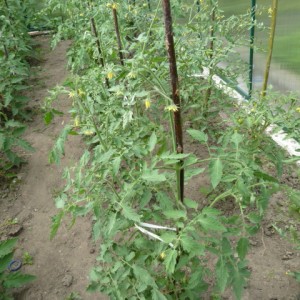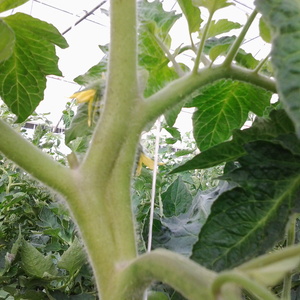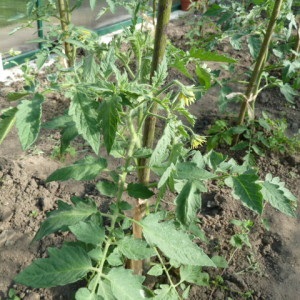Why the color of tomatoes in the greenhouse falls: what to do to save your tomato crop
In Russia, tomatoes began to be grown in the 18th century. Then the vegetable was accepted with distrust, and now it rightfully takes pride of place on the table. Tomatoes are cultivated in almost every garden plot. However, it is not always possible to get a good harvest of this crop. The homeland of the tomato is the tropical regions of South America. There are still wild varieties of tomatoes there.
In our climate, it is not easy to provide the necessary conditions for the formation of ovaries and the ripening of tomatoes. One of the common problems when growing a crop in a greenhouse is discoloration. Today we will tell you about the rules that must be followed in order to avoid the loss of color in tomatoes.
The content of the article
Reasons for color drop

In a temperate climate zone, tomato is not easy to cultivate. The plant is demanding for light and heat due to its southern origin. This explains the problems that gardeners face when cultivating a crop.
Why does tomato color drop in a greenhouse? There are several reasons for this.
Increased soil moisture
Providing tomato bushes with water is one of the most important conditions for their growth and development. However, excessive moisture is harmful and leads, in particular, to the fact that the flowers of tomatoes fall off. It should be borne in mind that in the process of growth the plant's need for water is not the same.
The periods of maximum water demand are the times for seed germination and fruit loading.
Important! During the flowering period, plants must experience a certain moisture deficit. This inhibits the intensive growth of the green mass of the bush and stimulates the fruit setting.
At the same time, the soil should not be allowed to dry out, leading to the fall of flowers and even young ovaries.
Tomatoes in a greenhouse or greenhouse are watered in sunny weather in the morning. For irrigation, use settled water with a temperature of 20-25 ° C. Water very sparingly on the first inflorescences before fruit sets.
Waterlogging of the soil, among other things, leads to increased humidity in the greenhouse. An increased indicator is considered to be more than 60-70%. With a high moisture content in the air, fertilization of flowers does not occur, since the pollen sticks together and stops spilling out of the pollen sacs. Barren flowers wither and fly around.
In addition, excess water leads to infection of plants with fungal diseases and root rot.
Lack of sunlight
Light is the main factor in the life of plants, including tomatoes... Crops grown under greenhouse conditions are highly dependent on sunlight. Lack of natural light is a common reason that tomato ovaries dry out and fall off. In addition, with good lighting, tomato bushes tolerate cold snaps better.
When choosing a site for a greenhouse, pay attention to how it will be located relative to the sun. The installation site of greenhouses, greenhouses and film shelters should not be shaded by buildings and trees throughout the day. The ideal site is high, open and full of sun from sunrise to sunset.
It happens that the garden plot is small and there are many good fruit trees growing on it, which it is a pity to uproot.Then the place is chosen so that the sun enters the greenhouse from morning to noon. At the same time, you can expect that the plants will grow strong, bloom and bear fruit well.
Advice... Clean the walls and roof of the greenhouse from dust and dirt on a regular basis. This simple measure increases the sun's access to plants by 10–20%.
Temperature changes
One of the main conditions for obtaining a good harvest of tomatoes (especially early ones) is maintaining the temperature regime that is optimal for the culture.
The tomato is very sensitive to heat and cold. Temperature changes lead to the appearance of a large number of barren flowers, drying out and falling of flowers.
Attention! Small and weak flower stalks signal that the bush lacks heat.
In hot weather, ventilation is saved from overheating of plants in a film shelter. It is good to install dark containers with cold water in the greenhouse - they collect excess heat.
Heaters save in case of cold snap.
Tomatoes are watered only with warm water under the root, making sure that the water does not get on the leaves and flowers.
Bushes too close
Dense planting is one of the common reasons that a plant sheds flowers without setting fruit. If the tomatoes are planted too close to each other, the air flow to the bushes is hampered, excess moisture does not evaporate. Plants begin to ache and shed their peduncles.
Incorrect fertilization

Another common mistake is improper feeding of tomatoes. Often, gardeners, trying to get the maximum possible yield, violate the timing and dosage when applying fertilizers.
An excess of nutrients leads to the "fattening" of plants. The bushes build up a lot of greenery, form powerful shoots, but do not form fruit.
Lack of nutrients is just as damaging to the crop as excess. With a lack of magnesium, for example, yellowed areas appear on the leaves, photosynthesis is impaired, and the quality of fruits decreases.
Diseases

Diseases of tomatoes are another likely cause of shedding flowers.
Gray and white are very dangerous rot... They usually develop at the base of the fruit. Gray mold is a watery gray spot that quickly spreads to the entire fruit. When affected by white rot, the tomato is covered with white mycelium. Disease also affects stems, leaves and inflorescences of tomatoes.
Another common disease is late blight... You can recognize an infection by dried, twisted leaves with brown spots. The disease develops rapidly and affects both the formed fruit and the ovary.
Poor seed quality
Weak and diseased seedlings grow from low-quality seeds. Therefore, the choice of seed should be taken seriously. Be sure to pay attention to the production date and expiration date printed on the packaging. Purchase seeds from trusted suppliers.
Pollination problems
Pollination problems also cause shedding of flowers on tomatoes. Pollination of tomato has its own characteristics.
The pollen is formed at night and matures at temperatures no lower than 15 ° C. If it is colder in the greenhouse, the pollen does not ripen and cannot set fruit.
Pollination of flowers occurs during the day. If at this time it is too hot in the greenhouse (more than 30 ° C), the ripened pollen becomes sterile. As a result, a barren flower is formed, and the flowers crumble without setting fruit. Temperatures below 14 ° C are also critical for fertilization and pollen germination.
In unstable weather conditions, the successful formation of ovaries is facilitated by the use of drugs that artificially improve pollination.
What to do to save the tomato crop
It doesn't matter what mistakes caused the flowers to fly around. You can save the tomato crop. The first thing to start with is to create the right microclimate in the greenhouse.
Creating the right microclimate
Greenhouse microclimate is understood as a combination of air and soil temperatures, their humidity, illumination, air movement and its composition.The microclimate is never constant. It changes with the change of day and night, in sunny and cloudy weather, when the building is ventilated.
For growing tomatoes in greenhouses, the temperature must be constantly monitored, starting with seed germination and ending with fruiting.
It is important to know: the optimum temperature for tomatoes in greenhouses during the day is 20-22 ° C, at night - 16-18 ° C (before flowering). When the tomatoes bloom, the greenhouse should be 26–32 ° C during the day and 14–16 ° C at night.
The temperature should not fall below average values, otherwise the formation of buds will stop. If the values are below 10 ° C, the plants will stop growing. At elevated rates (36–40 ° C), seedlings may even die.
Airing helps to regulate the temperature. Soil moisture is maintained within 80%, and air - 60%.
The creation of proper light conditions is facilitated by the use of less shading greenhouse structures, the choice of the correct location on the site, competent plant placement schemes and their formation.
Attention! The microclimate of a greenhouse will never be favorable without constant human intervention.
Compliance with landing rules
In order to correctly calculate the planting scheme, they are repelled by the growth strength of a bush of a particular variety or hybrid. Tall tomatoes are planted less often, 3-4 bushes per 1 square meter.
Medium-sized plants have 4-5 pieces per 1 square meter.
Pollination, spraying and feeding
Outdoors, tomatoes are pollinated by wind and insects. In the greenhouse, natural pollination is facilitated by drafts and plants that attract bees.
If this is not enough, special preparations that stimulate pollination help to increase the number of ovaries.
Important! It is not recommended to spray the bushes in the heat. Some formulations are capable of burning foliage.
Correct fertilization also helps to correct the situation. To set new inflorescences, plants are fed with nitrogen, potassium and phosphorus agents.
Correct bush formation
The number of flowers directly depends on the number of stems and branches. The more the bush grows, the more color is formed on it. However, more does not mean better. A short summer will not allow all the fruits to ripen. Therefore, the growth of a tomato bush is limited to pinching.
Preventive measures
Prevention of color loss in tomatoes includes measures for artificial pollination, timely fertilization in the correct dosage, and protection of plants from diseases and pests.
Fertilization stimulates the formation of a large number of ovaries. The plants are fed before flowering.
Treatment of bushes with a solution of copper sulfate protects against diseases. Plants weakened by infections will not be able to set fruit, so prevention is very important.
Experienced agronomist tips
To avoid color dropping on tomatoes, experienced agronomists give the following recommendations:
- Use artificial pollination... The pollen is most active in the morning, at 9-11 am. Walk along the rows of tomatoes at this time and shake the trellis or the plants themselves for better pollination.
- Additionally, use the preparations "Ovary" and "Bud"... These biostimulants improve fruit setting, increase yields by 15–30% and resistance to phytophthora by 4–6 times, and shorten the ripening period by 5–7 days. Spray the plants at the beginning of flowering of the first or second brush.
- Water moderately... Excess moisture leads to pollination problems and disease.
- Destroy in a timely manner aphids on tomatoes. Pests carry many viral diseases.
Conclusion
Maintaining an optimal microclimate in the greenhouse, competent fertilization, adherence to planting rules and prevention of diseases help to avoid drying and color loss on tomatoes. Do not neglect the recommendations, and the problem will be bypassed.